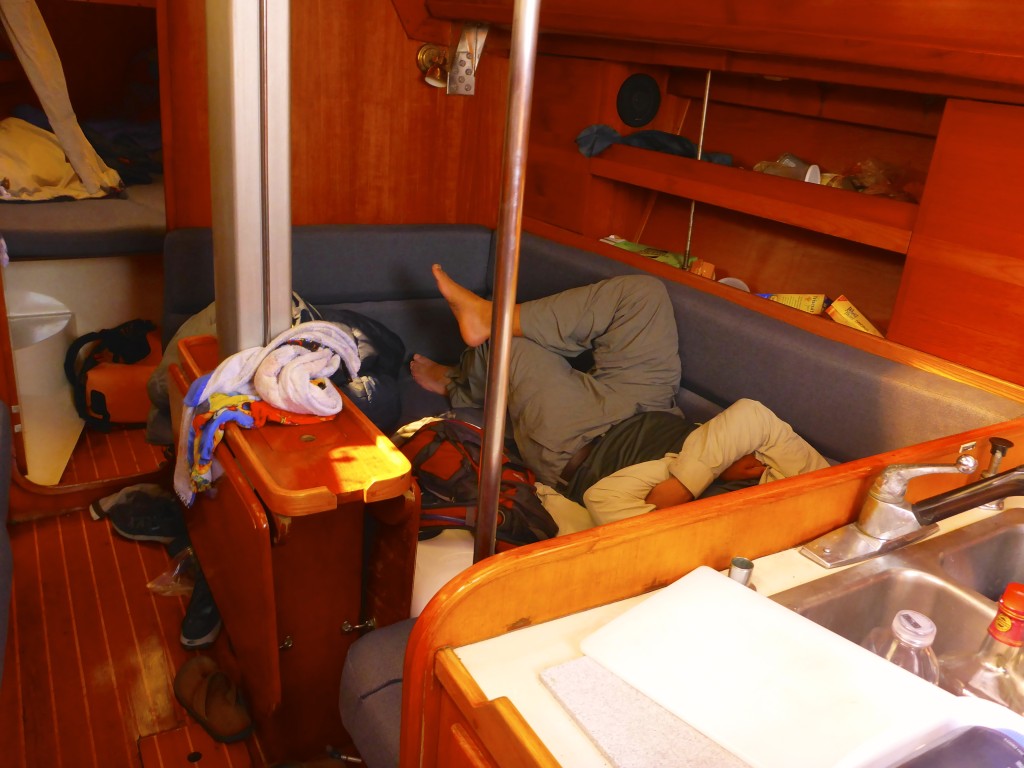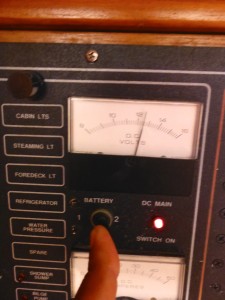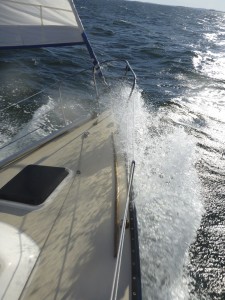The first time you spend more than a few hours on a big boat most of the new things you have to learn are below decks in the cabin. Most of these differences can be boiled down to conservation; conservation of resources that are limited on a boat including electricity, water and space. Fortunately they’re mostly simple behavioral considerations, only one is tangentially related to safety. Here is a quick primer on the essentials and gotchas.

The Head – Toilet Talk
The toilet on a boat is referred to as a Marine Head and it’s operation is simple once you get the hang of it. On the other hand on one end it is plumbed directly to a tank of human waste and on the other it’s plumbed to the sea outside the boat so the cost of getting it wrong can be very high. The consequences of using the marine head can range from a disgusting mess to sinking the boat.1On a hot summer day I went below and noticed the cabin sole was wet where it … Continue reading
Before your first time using the head on any boat make sure you ask the skipper or one of the regular crew if there are any special tips (I still always ask). If you have any doubts or you’ve never used a marine head before ask them to show you how. If you’ve forgotten since last time ask again. Make sure to ask about and remember how they deal with toilet paper. If anything with the head seems wrong bring it to the attention of the skipper or regular crew immediately.
The marine head is nobody’s favorite topic nor is it where anyone wants to spend extra time; the cost of getting it wrong, however, is so high that experienced sailors are accustomed to and appreciate hearing about head questions or concerns. We all have heard or experienced head horror stories and appreciate that any amount of prevention is far better than dealing with a head mess ourselves.
Water Conservation
Most sailboats between 30’ and 50’ have somewhere between 40 and 160 gallon water tanks. Even if you don’t use this water for drinking you’ll run out of water very quickly unless you take measures to conserve it. This conservation will be obvious when you take a shower or do the dishes.
Showers
A normal 20 minute shower with a low flow shower head would use 40 gallons of water which is somewhere between ¼ and all of the total fresh water aboard a 40’ sailboat. Unless you’re tied up to a dock with running water normal showers where you leave the water running won’t work. (If you are tied up to a dock you’ll probably be happier using a shower ashore)
Generally this means you take camp showers. Get in the shower, get your hair and person wet, turn off the water, apply shampoo and soap and then quickly rinse off from the top down.
Another option in the tropics is to use the shower on the stern platform. Jump in for a salt water rinse then stop onto the swim platform, add some fresh water to the salt water (normal soap won’t lather in salt water) and then proceed with your camp shower. If you’re lucky you can air dry in the sun. Sometimes you can take a shower when it rains to save even more fresh water but fair warning, even in the tropics the rain is quite cold.
Dishes
Dishes are similar to showers, you simply don’t have enough water to leave the faucet running while you’re cleaning dishes.
We fill part of a large pot or a sink with hot soapy water. It’s important to have hot enough water; often this requires heating up water on the stovetop. We then use this soapy water to wash all the dishes, using elbow grease instead of running hot water to clean off sticky food. Once all the washing is done we make another pass at everything rinsing it using the faucet. Sometimes, depending on the condition of the water in the tanks, a second rinse using our drinking water is done. We usually dry the dishes and stow them right away because the galley space is so limited.
Keep water conservation in mind whenever you’re using the boat’s fresh water; showering, doing dishes and even something as simple as washing your hands.
Drinking Water
I’ve never been on a boat where drinking from the faucet (connected to the boat’s tanks) was standard practice. Most of the time drinking water is kept in separate, often store bought, plastic containers. Do what the experienced crew does and if in doubt bring your own water bottle.
Pack Squishy
When you move up to big boats you’re likely to be doing your first multi-day trips; you’ll need your gear and changes of clothes. You’ll want to pack in a squishy bag such as a duffel bag and leave your rigid suitcase with wheels at home. Boats tend to have plenty of stowage for personal gear but the stowage spaces that are out of the way tend to be oddly shaped and awkward for a rigid suitcase; even one as small as a carry on bag.
I have a great internal frame backpack that I use for camping and traveling. When I get it aboard I take out the frame and other rigid components which converts it into a easily stowable duffel bag. It’s almost ideal for traveling that includes sailing.
If my internal frame pack were waterproof it would be ideal for sailing use. If you’re really cramped for room it’s very convenient to be able to stuff your waterproof bag up the nearest hatch and leave it tied to the deck overnight without having to worry about rain or condensation dampening your gear.
Electricity Aboard
On a sailboat electricity is generated by the engine and stored in a battery bank; electricity is limited aboard. Only DC electricity is available unless you’re plugged into shore power. You’ll notice the skipper making sure the batteries are topped up probably twice a day and keeping an eye on the charge. To start you’ll just have to contribute to electricity conservation.
The Distribution Panel

Often to conserve electricity circuits are turned off at the main distribution panel. This ensures that something is not accidentally left on in the cabin when it’s not needed and keeps the unused electronics from slowly draining the battery. Often times this means that to turn something on you have to turn it on at the distribution panel and then at it’s switch. If you turn a switch on to use something turn it off when you’re done or let people know that you’ve changed the distribution panel.
Often it’s tricky to figure out what switch goes to what you’re trying to turn on. If you have any doubts ask the skipper or regular crew. Some switches can have unintentional consequences that are not obvious. I’ve been aboard a boat that tried to pump all of it’s fresh water overboard because the pressure water pump was accidentally switched on and the sink had a leak. If you flip on the macerator trying to turn on the radio while people are out swimming you’re going to have some pretty pissed off crew.
If you pay attention you quickly become accustomed to operating the distribution panel on a boat; there is plenty of cause to use it every day you’re out.
Your Own Devices
Without AC power many charging plugs don’t work. If you have a two or three prong charging device it will only work if the boat is plugged into shore power. The chargers that work when not on shore power are those that plug into a car’s cigarette lighter style outlet. If somebody brought along a cigarette lighter to USB adapter (affiliate link) charging many devices becomes far more convenient.
Close Quarters Living
The cabin of a big boat is still cramped living conditions. Contribute to the general happiness of the crew by cleaning up after yourself, keeping your gear stowed out of the way, not using up too much of the common space and the other small considerations that contribute to a tidy and comfortable space below.
I like to think of the cabin of the sailboat as a really luxurious campsite instead of a really cramped hotel room 🙂
Sand and Seawater

I’ve come to realize that sand and seawater are purpose built to make the cabin of a boat uncomfortable. When something gets wet with saltwater it takes many times longer to dry than fresh water, even in the tropics. Cloths and cushions that get saltwater on them have a damp chill often until they can be taken above deck in the sun to dry. Moreover the cabin doesn’t get much circulation or direct sunlight so it takes that much longer. The salt stays behind after the water evaporates so adding fresh water restarts the misery. Be careful where you sit down in wet clothes; you could be making someone’s bunk damp for the whole night. Whenever the boat is moving keep all the hatches closed.
Sand is easier to keep out but just as insidious once below; given the maneuvering often necessary to enter your berth sand on your feet often leads to sand on your pillow. Dust your feet off before you enter the cabin or climb into your berth. Leave your shoes on deck if you can. Dry out and shake off sandy towels before bringing them below. Keep in mind which other berths are in use.
Hopefully this article gives you some idea how things are done differently in the cabin on a sailboat. But, if you only take one thing away from this article, it should be that your instinct whenever you’re aboard and not sure should be to ask someone else. You’ll learn quickly that way and avoid many of the hiccups that the other sailors aboard have experienced. And don’t worry, if you’ve acclimated to the world moving and heeling underneath you the few things you have to remember below will come easy.
References
| ↑1 | On a hot summer day I went below and noticed the cabin sole was wet where it shouldn’t be. The head was left set to ‘wet’ and the pump handle wasn’t secured; seawater was forcing it’s way into the boat. Left unchecked this could have slowly filled the boat with water, fortunately I caught it early. It was tough to clean up but raw seawater is the least disgusting mess that can be caused by improper head use. |
|---|
Leave a Reply